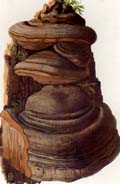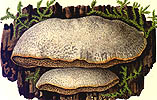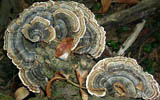 Key to Gilled Mushrooms Key
Key to Gilled Mushrooms KeyThis is a key to gilled mushrooms, that is, mushrooms having a definite cap with a fertile surface consisting of gills. The fruiting body usually also has a stem, although that may be lateral or absent (usually, then, the mushroom is growing from wood). You can use this key to identify mushrooms that you find.
 Polyporaceae Family
Polyporaceae FamilyFertile surface usually a layer of vertical tubes, of which the mouths are visible as pores on the underside of the cap or shelf.
Fruiting bodies usually tougher or harder than the "normal" gilled mushrooms, being leathery, corky, or woody. But they can be quite tender while actively growing
Once grown, they do not decay easily, remaining on the substrate for months or years
They often grow on wood, although a few are terrestrial (even those are usually growing on buried wood)
Fruiting body is usually a flat shelf, or hoof-shaped, protruding directly from the substrate, although sometimes it may have a short stalk.
Some forms never grow away from the substrate at all, so that all that is visible of the fruiting body are the pores.
Sometimes the pores are so minute that the fertile surface seems solid, until you look closely
 Lignicopolypore Subfamily
Lignicopolypore SubfamilyGrowing on wood
Sessiloporus TribeNot fitting the other choices, not stipitate
In making choices below based on texture and size, place the emphasis on texture: if left alone, some of the smaller ones can eventually get quite big; and even the huge ones have to start out small at first
 Small Sessilopolypore Subtribe
Small Sessilopolypore SubtribeIndividual caps small (max. 2-3" across)
Soft or tough, but not hard when fresh, although they may become hard when they dry out
All thin-fleshed fruiting bodies go here, especially if compound or imbricate
 Small Imbricate Polypore SemiTribe
Small Imbricate Polypore SemiTribeFruiting in dense clusters of thin-fleshed shelving fruiting bodies
 Trametes Genus
Trametes GenusCap surface usually furry
Cap either thin, tough and zonate; or whitish, thick and corky
Trimitic hyphae, yet fruiting body not hard
Spores inamyloid, cylindrical
Duplex Trametes Section

Diagnosis
Comments
This section more or less follows the genus/section Coriolus of Quélet: he declared this new genus based on Trametes versicolor, with the rationale that the species like versicolor really didn't resemble Trametes suaveolens (the type species for Trametes) very much
Quélet's genus has been abandoned, but it is still a useful way to divide Trametes up using only field characteristics
Narrow down your identification:
Trametes hirsutaCap duplex (sometimes only at base): upper layer gray, soft and fibrous, densely hairy; lower layer off-white, corky, up to 3/4" thick
Up to 6" (occasionally up to 12") across; sometimes zonate, but without great contrast in the colors of the zones; margin sometimes yellowish brown
Trametes pubescensCap cream to pale tan, hairy, not zonate
 Trametes versicolor
Trametes versicolorCap furry, zonate with sharp contrast in color and hairiness between adjacent zones
Often clustered, imbricate, or compound
Flesh thin (cap and tube layer each 1-2 mm thick), leathery






 Key to Gilled Mushrooms Key
Key to Gilled Mushrooms Key Polyporaceae Family
Polyporaceae Family Small Sessilopolypore Subtribe
Small Sessilopolypore Subtribe Trametes Genus
Trametes Genus




